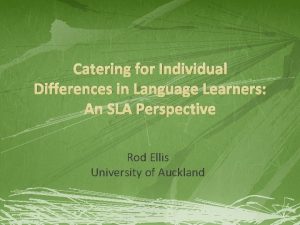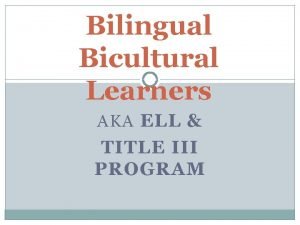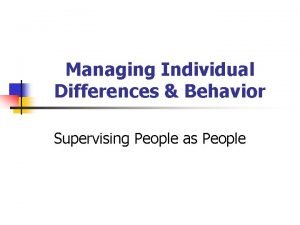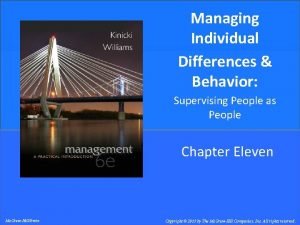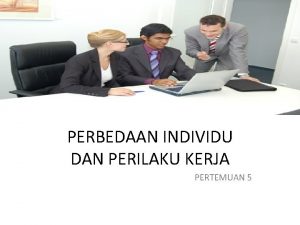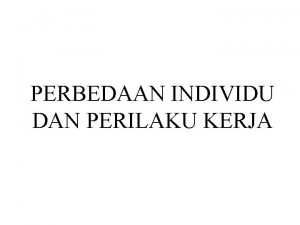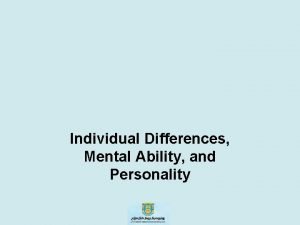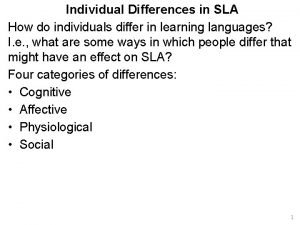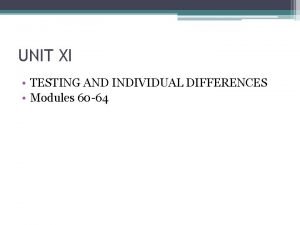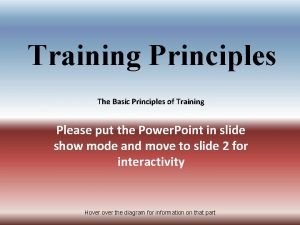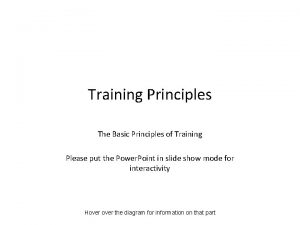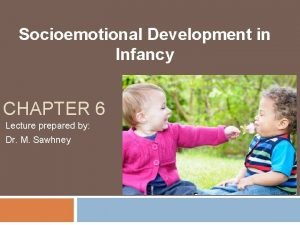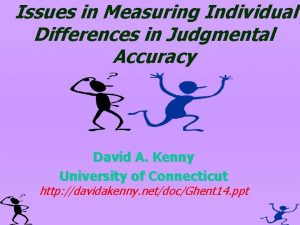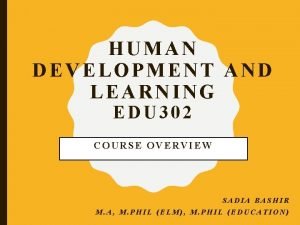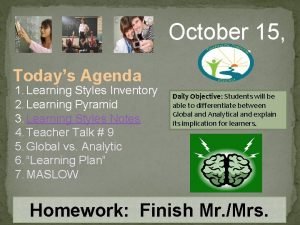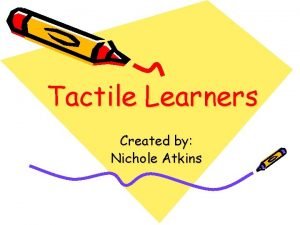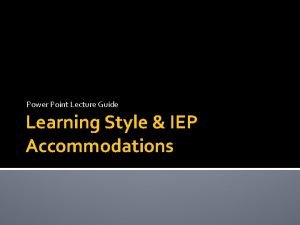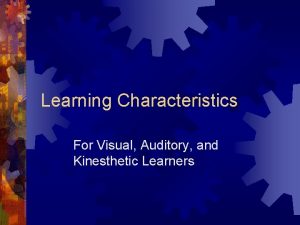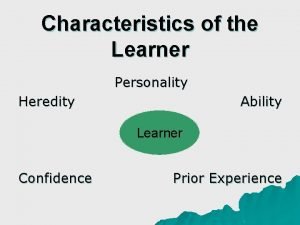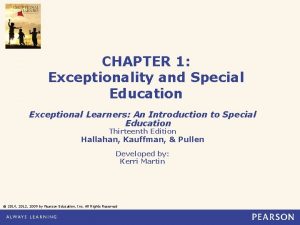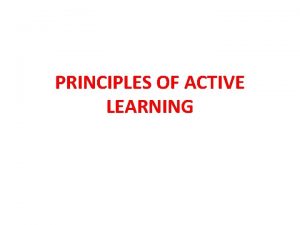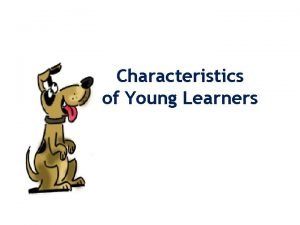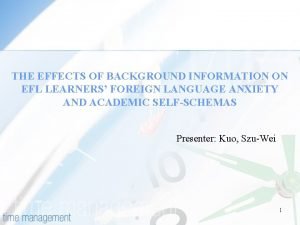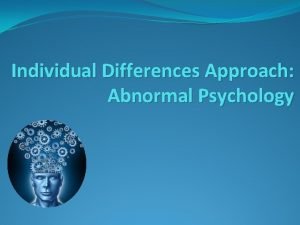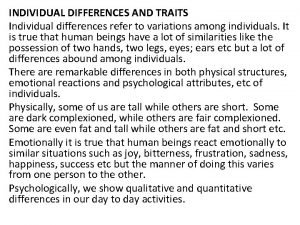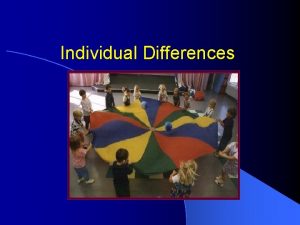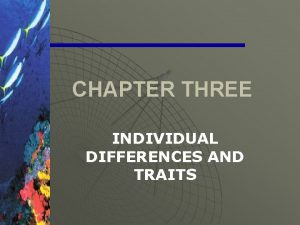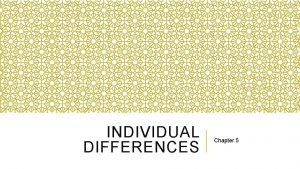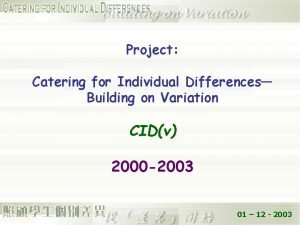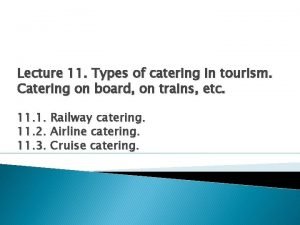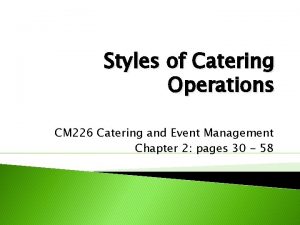Catering for Individual Differences in Language Learners An



































- Slides: 35

Catering for Individual Differences in Language Learners: An SLA Perspective Rod Ellis University of Auckland

The challenge Perhaps the biggest challenge facing teachers is how to accommodate individual differences in their students. The purpose of this talk is to: 1. Examine how learners differ 2. Consider the different ways in which teachers can take account these differences

Types of individual learner differences 1. 2. 3. Factors that represent more or less permanent and stable aspects of learners (e. g. intelligence, language aptitude, working memory and personality) Factors that are mutable, dynamic and situated (e. g. motivation and anxiety). Learner beliefs and learning strategies. These function as mediating variables (i. e. they influence the effect that other factors have on learning).

Two ways of catering for individual learner differences Factors Two ways of catering for individual learner differences Permanent/stable factors The teachers will need to find ways of adjusting their teaching. Teachers cannot hope to change learners’ aptitude or personality so they must accommodate their teaching to take account of how their learners differ. Mutable/ dynamic factors The teachers can try to modify them in order to increase their impact on learning. Mediating factors

Teacher Guides Ur (1996) Nunan (1991) Scrivener (2005)

Nunan (1991) has a chapter entitled ‘Focus on the Learner’ in which he considers learning styles and strategies. He includes a lengthy discussion of the ‘good language learner’. However, he provides only the briefest of comments about motivation in a list of ‘things that helped learning the most’.

Ur (1996) includes a lengthy discussion of just two factors: 1. Motivation –– integrative vs. instrumental. Ur acknowledges its ‘sheer importance’ for successful language learning. 2. Age –– she sees age as influencing language learning in terms of differences in the capacity for ‘understanding and logical thought’ and also in motivation (i. e. adult learners are more analytical than children and may have a stronger motivation to learn).

Scrivener (2005) lists a whole host of ways in which learners differ but went on to consider only three: 1. Motivation 2. Multiple Intelligences (H. Gardner, 1983) 3. Sensory Preferences (an aspect of learning style). He then focuses on whether teachers should ‘teach the class or teach the individuals’ but offers no concrete advice about these might be handled.

Some general comments 1. The teacher guides address a wide range of factors. 2. The authors of the books are quite selective in the specific factors they choose to focus on but do not attempt to justify their choice. 3. There is no mention at all of working memory and also very little mention of language aptitude. The guides offer very little in the way of practical suggestions about how teachers can cater for individual differences in their students.

Possible ways of catering for individual differences 1. 2. Focus on a specific factor that is considered of special importance –– but the teacher guides differ in the factors they view as important. Tudor (2001) –– learners cannot be really treated as ‘discrete bundles of variables’ so teachers need to accommodate the individual learner in a more holistic manner.

Equip learners to become ‘good language learners Characteristics of good language learners: ü a concern for language form ü a concern for communication (functional practice) ü an active task approach ü an awareness of the learning process ü a capacity to use strategies flexibly in accordance with task requirements

Problems with the ‘good language learner’ 1. 2. The Good language Learner studies overemphasize the commonalities among good language learners. Hall (2011) –– the characteristics seen as desirable reflect those of Western cultural norms and traditions of learning and ignore that strategies (e. g. rote-memorization) that learners from other cultures employ with success.

Addressing individual differences in language pedagogy Select learners Grouping learners Instruction matching Eclecticism Addressing Individual Differences Outside the classroom Cater for differences Individualization Inside the classroom Strategy training Learner training Promote receptivity Awareness raising

Selecting learners This involves identifying learners who are ‘good’ at learning a foreign language. 1. But learners cannot be considered as ‘good’ or ‘bad’ at learning languages. 2. Selection is not possible in most instructional contexts.

Catering for individual differences(1): Instruction matching Aptitude-treatment-interaction research (e. g. Wesche, 1981) shows that learners learn better if the instruction matches their abilities for learning. Problems: 1. Learners differ in multiple ways. 2. Impractical in most teaching situations.

Eclecticism A more practical way of carrying out learnerinstruction matching is by including a mix of instructional activities for the whole class. However, addressing learner differences through a mix of activities calls for principled eclecticism not ‘irresponsible adhocery’ (Widdowson, 1979; 243). But there are no agreed principles for defining and implementing eclecticism based on individual learner differences. By and large, teachers have to rely on their intuition.

Catering for individual differences : (2) Individualization ‘A situation where learners are given a measure of freedom to choose how and what to learn’ (Ur, 1996). 1. Inside the classroom by allowing learners to work on activities of their own choice. 2. Outside the classroom through self-access centres

Individualization inside the classroom Altman (1980) suggested that activities can be individualized according to: 1. time allocated for learning 2. the curricular goal 3. the means for achieving the curricular goal (i. e. mode of learning) 4. instructional expectations (i. e. the level of learning expected)

Problems § § § But such individualization is demanding on teachers’ time and management skills and it is impossible to accommodate combinations in all of these variables. An inspection of modern language teaching text books also suggests that individualized instruction has had little impact. By and large language pedagogy pays only lip service to the idea of individualized instruction in a classroom setting.

Individualization outside the classroom – the Self-Access Centre Cotterall and Reinders (2001): “A Self Access Centre consists of a number of resources (in the form of materials, activities, and support), usually located in one place, designed to accommodate learners of different levels, styles, goals and interests. It aims at learner autonomy among its users”. (p. 24)

Problems § Learner factors receive little attention when setting up a centre. Instead the focus is on providing learners with learning materials appropriate to their needs and proficiency levels. § Reinders (2012) ––‘there is no clear focus on the individual’ (p. 3). § He argued that there was in fact less need for ‘walled gardens’ these days as learners are able to connect with multiple resources via the worldwide web in entirely individual ways.

Catering for individual differences(3): Learner Training The aim of learner training is to enable learners to make the most of their learning opportunities. Two approaches: 1. strategy-training to equip students with effective ways of learning 2. awareness-raising activities aimed at making learners aware of their own preferred ways of learning and of alternatives.

Strategy training Cohen (2003) defined strategy training as involving: 1. explicit instruction (i. e. the teacher explains how, when and why to use certain strategies and also models their use) 2. practice (learners are given the opportunity try out of the strategies in a variety of tasks). Learner training is frequently endorsed by teacher educators and many text books now include some form of strategy by systematically incorporating learning-how-to-learn tasks into normal teaching activities.

Problems § Doubtful whethere is a common set of strategies that are effective for all learners. § Macaro (2006) –– very difficult to reach any firm conclusions regarding the effectiveness of training learners to use specific strategies. In other words, it is not clear what strategies the training should focus on or whether training the use of them actually improves learning. § Plonsky’s (2011) meta-analysis of strategy instruction studies indicated that it is effective

Making strategy instruction effective Two ways in which strategy training can be made effective: 1. Training is provided in the use of a specific strategy (e. g. monitoring) 2. Use of the strategy needs to be incorporated into a specific language learning activity (e. g. the performance of a particular communicative task). 3. Learners need to verbalize the strategy as they perform the activity. It is through the process of verbalisation that learners achieve selfregulation in the use of the strategy.

Holunga’s (1995) study S: I choose Smit because he need it. No … it’s conditional. I would give Smit … I would choose Smit because he need the money. Right I WOULD give … T: Needs it. S: Yes, because he need it. T: Yes, but no. He needs. ‘s’, you forgot ‘s’. He needs. S: Did I? Let me listen to the tape (Listens to the tape). Yes … yes. He needs. I have a problem with ‘s’. I paying so much attention to conditionals I can’t remember ‘s’ … Maybe a good idea to listen to tape after we each talk.

Awareness-raising Ø Awareness-raising activities consist of various kinds of tasks designed to both help learners make explicit their own beliefs and preferred strategies and also to expose them to alternatives (e. g. Ellis and Sinclair, 1989). Ø The aim is not to induce immediate change in strategic behaviour but to encourage learners to reflect on their beliefs and learning behaviours. Ø However, awareness-raising is unlikely to have an immediate effect on learning and as with strategy training, there is only limited evidence that it effective.

Catering for individual differences(4): Receptivity Allwright and Bailey (1991) define receptivity as ‘a state of mind, whether permanent or temporary, that is open to the experience of becoming a speaker of another language’ and defensiveness as ‘the state of mind of feeling threatened by the experience and therefore needing to set up defences against it’ (p. 157).

Key factors in receptivity and defensiveness 1. Motivation –– Hall (2011) suggests that the most fundamental issue facing teachers is how to motivate students. 2. Anxiety –– three major sources of anxiety: apprehensiveness about communicating in the L 2 in front of the whole class, competitiveness (i. e. the negative self-evaluation that arises when learners consider themselves less successful learners than their classmates) and language tests (Horwitz, Horwitz and Cope 1986) – humanistic language teaching

Motivation is a complex construct. It involves: 1. The reasons a learner has for needing or wanting to learn an L 2 (i. e. motivational orientation). 2. The effort a learner is prepared to make to learn the L 2 and the impact that the learner’s immediate context has on this (i. e. behavioural motivation). 3. The effect that the learner’s evaluation of his/her progress has on subsequent learning behavior (i. e. attributional motivation).

Promoting motivation Teachers ability to influence the ‘needs’ and ‘wants’ of learners are limited in many teaching contexts. Therefore main focus needs to be on: Ø Encouraging behavioural motivation Ø Helping learners to make evaluations of their successes/ failures that will foster subsequent effort. See Dornyei (2001)

Importance of acknowledging students’ individuality The movie ‘Kes’. Richards (2006) Ø Default identity (i. e. teacher-as-teacher; student-as-student Ø Transportable identity The classroom interactions that result from transportable identities: Ø Recognize students as individuals Ø Result in richer interactions that create contexts for language acquisition

An example In this extract from a lesson involving Taiwanese students a student ‘transports his identity’ as a maker of war models into the talk in order to explain why he likes the ‘swastika’ insignia and to refute the teacher’s assumption that he does not understand the significance of this.

1. 2. 3. 4. 5. 6. 7. 8. 9. 10. 11. S 1: But in fact, in Taiwan, many boys like th swasi-, swastika T: But I feel they don’t really understand. S 1: No, we understand. You know why. After, after …. S 2: Really? (Sceptically to S 1) S 1: Yeah, like me, you know, I played, no I made, the, the model. You know? The war models ‘muo shin’. S 3: Game. S 1: Yeah. S 3: Game. World War II game. S 1: No, no not game, muoshin. You know? T: A model. S 1: Yeah, to make a tank ….

Conclusion: Catering for differences through interaction Catering for individual differences is not just a matter of choosing instructional materials to suit different students and even less a matter of teaching them learning strategies. ü Above all, it is a matter of engaging fully with learners through the interactions that take place. We accommodate differences in the people we meet in our daily lives in the way we interact with them and this is how teachers can best ensure that they treat learners as ‘complex human beings’. ü
 Catering for individual differences
Catering for individual differences Field dependent vs field independent
Field dependent vs field independent Assistive technology for english language learners
Assistive technology for english language learners English language learners
English language learners Reading strategies for english language learners
Reading strategies for english language learners Cr part 154
Cr part 154 Standard language
Standard language Managing individual differences and behavior
Managing individual differences and behavior Proactive personality
Proactive personality Perbedaan individu dan perilaku kerja
Perbedaan individu dan perilaku kerja Hukum perbedaan individu adalah
Hukum perbedaan individu adalah Individual differences factors
Individual differences factors Individual differences in sla
Individual differences in sla Unit xi testing and individual differences
Unit xi testing and individual differences Variation principle of training
Variation principle of training Principles of training individual differences
Principles of training individual differences Involves individual differences in behavioral styles
Involves individual differences in behavioral styles Conclusion of individual differences
Conclusion of individual differences Edu 302
Edu 302 Global vs analytical learners
Global vs analytical learners Teaching grammar for young learners
Teaching grammar for young learners Tactile learner definition
Tactile learner definition 10 objectives of remedial instruction
10 objectives of remedial instruction Global vs analytical learners
Global vs analytical learners Characteristics of visual learners
Characteristics of visual learners Eager learner examples
Eager learner examples Kinesthetic learners learn best by
Kinesthetic learners learn best by When is cognitivism beneficial for learners
When is cognitivism beneficial for learners Domain 3 diversity of learners examples
Domain 3 diversity of learners examples Article xi of the code of ethics for professional teachers
Article xi of the code of ethics for professional teachers Characteristic of learners
Characteristic of learners Exceptional learners: an introduction to special education
Exceptional learners: an introduction to special education Principles of active learning
Principles of active learning Involuntary attention meaning
Involuntary attention meaning Questioning and discussion techniques
Questioning and discussion techniques Background information for learners
Background information for learners
